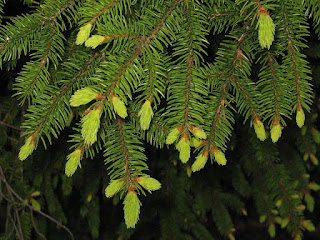With all the recent rain, it's worth taking a walk to appreciate evergreens. Spring rains not only highlight the beauty of evergreens in your neighborhood, they sponsor some amazing growth in those trees. Bright green new growth can be seen on the tips of spruces and pines of all shapes and sizes. The white pine in my neighbor's yard is adding an impressive 6-8 inches of new growth on each branch. The new needles on each branch start out short and stubby, but they are on their way to adding inches themselves. The fresh spring growth on evergreens reminds us that some trees have a fascinating habit of replicating themselves, of repeating the patterns of their branching as they grow. Redwoods, for instance, replicate the general overall pattern of the tree as they grow new branch systems.
 |
| fractals in tree growth |
Each tree's pattern, like that of a snowflake, is unique to that tree, and as they grow they keep re-iterating this unique signature pattern-- this is called a fractal. Trees are living math! And water, sunlight and nutrients are the raw materials for this math, the map of their existence! For more on fractals, visit the
Fractal Foundation website.
 |
| new growth pine needles are "candles" |
So take a walk this week and seek out evergreens. If it's been raining, you can admire the way water beads on their needles or the electric color of the tender new growth. If you have time, you can stop and sketch the branching habit of the tree-- take a look at the pattern of the tip of each spruce branch and sketch the replication. Why does the tree branch? What is it hoping to capture? (think of those raw materials, the sources of energy).
If you want to get to know a tree a bit better, pluck a small number of needles from the tree and crush them between your fingers; notice the different fragrances of each evergreen type. Do all spruces smell alike? It is not only possible, but very easy to make a light and fragrant pine needle tea or simple syrup. Harvest some white pine needles and rinse them off. Bring water to a boil and steep needles for a few minutes to enjoy tea or bring a 50/50 blend of water and sugar to a boil, add needles and reduce mixture until you have syrup. Remove needles. You can pour over vanilla ice cream or create your own signature beverage: pour pine syrup over ice, add seltzer water, and, if you are a grown-up, maybe a jigger of your favorite spirit. *Please know your trees-- don't try steeping hemlock or yew-- they are poisonous!
The Raven, by Gerald McDermott, is a great, misty-moisty, north pacific tale to read when enjoying evergreens, or pine needle tea.
Methuselah, Pinus Longaeva, is the oldest pine on earth-- circa 2831 BC--4847 years old. Great Basin bristlecone pine growing in the White Mountains of Inyo County, California. More info at Nova's
Methuselah website.
To visit old growth coniferous forest here in Minnesota,
check out the DNR's old growth forest info page.
 |
| Methuselah |





No comments:
Post a Comment
Please share your ideas with The Firefly